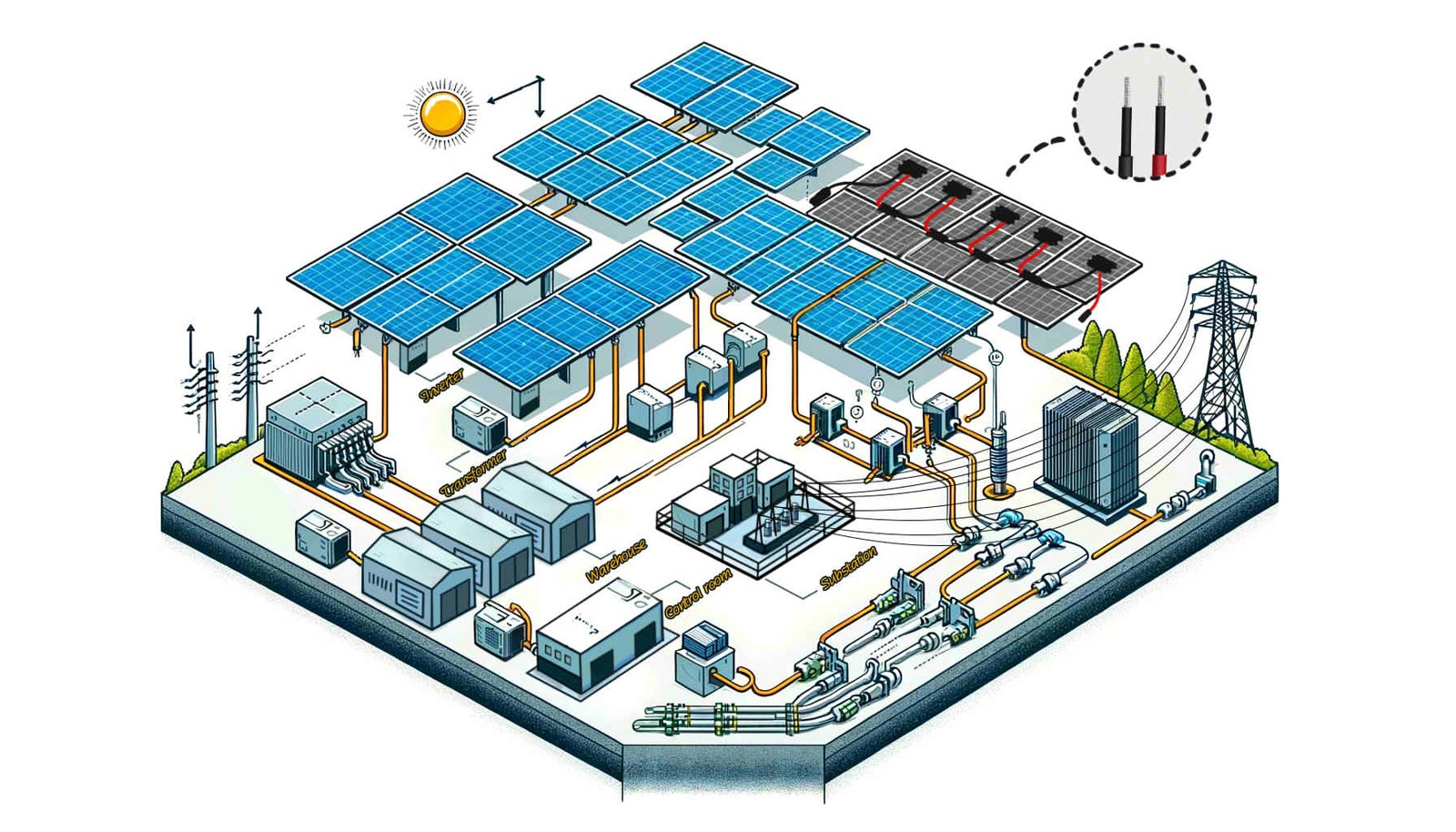Әлем жаңартылатын энергияға қатысты, Күн қуаты электр энергиясының ең танымал және тұрақты көздерінің бірі ретінде пайда болды. Күн жобалары, тұрғын немесе коммерциялық болсын, мұқият жоспарлау және қарауды қажет етеді, Әсіресе, ол дұрыс компоненттерді таңдауға келгенде. Осы компоненттердің ішінде, Кабельдер тиімділікті қамтамасыз етуде маңызды рөл атқарады, қауіпсіздік, және күн электр жүйесінің ұзақ өмір сүруі.
Мазмұны
- Күн жүйесінің электр қуатын өндіру процесі
- Күн электр жүйелері үшін қандай кабельдер қажет?
- Фотоэлектрлік электр станциясында құрылыстың жалпы құнының қанша пайызын құрайды?
- Күн дК кабельдері туралы
- Неліктен фотоэлектрлік жүйелер үшін арнайы кабельдерді қолдану?
- Күннің кабельдеріне арналған TÜV сертификаты қандай?
- H1ZZ2Z2-K PV кабельдер үшін қандай сипаттамаларды таңдау керек?
- H1Z2Z2-K Photovollaic кабельдерінің DC және AC қосымшалары арасындағы айырмашылықтар қандай??
- H1z2z2-K және Pv1-F PV1-F фотоэлектрлік кабельдер арасындағы айырмашылықтар қандай??
- Pv1-F кабельдік сипаттамасын қалай таңдауға болады?
- Күндер неге қызыл және қара түске бөлінеді??
- Күн кабелінің қосқыштарын өзіңіз жасай аласыз ба??
- Жиі қолданылатын күн қосқыштары дегеніміз не?
- Күндік айнымалы ток сымдары туралы
- Жерге қосу жүйесіне арналған кабельдер туралы
- Неліктен күн энергиясын өндіру жүйелерін жерге қосу керек?
- Күн энергиясы жүйелерінде қандай жерге қосу қажет?
- Күн панельдері қалай жерге тұйықталған?
- Неліктен күн панельдерінің жақтауларын қосу және жерге қосу керек?
- Фотоэлектрлік жүйелердегі өзектерді жерге қосу үшін қандай материалды қолдану керек?
- Жер таяқшаларының қандай техникалық сипаттамалары жиі пайдаланылады?
- Фотоэлектрлік жүйелерде жер таяқшаларын қалай орнату керек?
- Үстеме кабельдер, Бақылау кабельдері және PV жобаларындағы байланыс кабельдері
- Күн жобаларында кабельдік бағыттауға арналған құқықтық және реттеуші талаптар
- Кабельдік маршруттаудың ең жақсы тәжірибелері
- Кабельдерді сатып алу үшін маңызды кеңес
- Соңғы ойлар
Күн жобасы үшін тиісті кабельдерді таңдау өте қиын міндет болуы мүмкін, Фотоолтаиктің әр түрлі нұсқаларын және нақты талаптарды ескере отырып (Пв) жүйелер. Бұл нұсқаулық күн жобасы үшін кабельдерді сатып алу туралы білуіңіз керек барлық нәрсеге жан-жақты шолу жасауға бағытталған. Күн энергиясын өндіру процесін түсінуден бастап әр түрлі қосымшалар үшін кабельдердің дұрыс түрлерін таңдау үшін, Біз сізге хабарланған шешімдер қабылдауға көмектесетін барлық маңызды аспектілерді қарастырамыз.
Осы нұсқаулықтың соңына қарай, Сіз өзіңіздің күн жобаңыз үшін кабельдерді сатып алу кезінде қарастырудың маңызды факторлары туралы нақты түсінікке ие боласыз, Сіздің жүйеңіздің жылдар бойы тиімді және қауіпсіз жұмыс істеуін қамтамасыз ету.
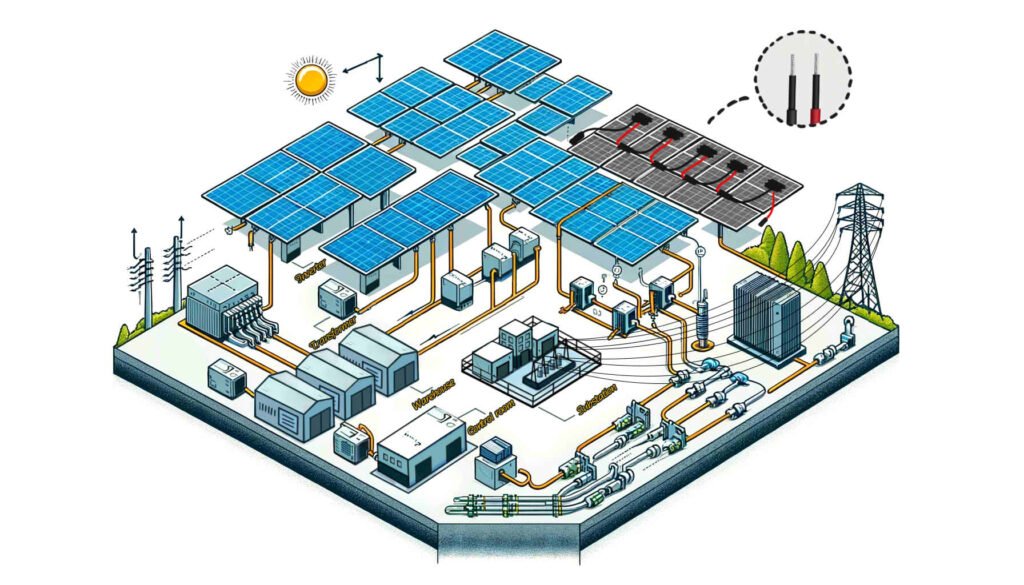
Күн жүйесінің электр қуатын өндіру процесі
Solar жүйесінің электр энергиясын өндіру процестерін түсіну PV жобасының оң кабельдері мен компоненттерін таңдау үшін өте маңызды. Тиісті кабельді таңдау жүйеде электр энергиясының тиімді және қауіпсіз жеткізілуін қамтамасыз етеді, Бұл торға қосылған немесе торлы қондырғы ма, жоқ па.
1. Күн сәулесін түсіреді
Күн панельдері, көптеген күн жасушаларынан тұрады, Фотондарда күн сәулесін түсіріңіз (Жеңіл бөлшектер) бетін ұрыңыз. Бұл фотондар энергияны күн батареяларының ішіндегі электрондарға жібереді, Электр тогын құру.
2. Электр энергиясын өндіру
Фотондардағы энергия электрондарды қуаттайды, оларды ағып, тікелей ток өндіре бастайды (DC). Күн панельдері әдетте үлкен массивтерде электр энергиясын өндіру үшін орналастырылған, үйлер үшін жеткілікті, Кәсіпорындар, немесе бүкіл қауымдастықтар.
3. Инвертерді түрлендіру
Күн панельдерімен құрылған тұрақты токтың электр энергиясын тұрақты тұрмыстық техника мен коммерциялық жабдықтармен пайдалану мүмкін емес, айнымалы токтың ішінде жұмыс істейді (Айна). Бұл олқылықты жою үшін, Инвертор DC электр қуатын айнымалы токқа айналдыру үшін пайдаланылады, оны стандартты электр жүйелерімен үйлесімді ету.
4. Беріліс және тарату
Айнымалы токқа айырбастаудан кейін, Электр энергиясы трансформаторға жіберіледі. Трансформатор электр энергиясының кернеуін арттырады, ол оны электр желілері арқылы ұзақ қашықтықта тиімді таратуға мүмкіндік береді. Жоғары вольтты айнымалы ток қуаты әр түрлі тұтынушыларға бөлінеді, оның ішінде үйлер мен бизнес.
Торға қосылған жүйелер
Торға қосылған жүйелерде, Процесс келесідей:
- PV панельдері DC Power жасайды: Күн панельдері күн сәулесін түсіріп, DC Power жасаңыз.
- Инвертор айнымалы ток қуатына айналады: Тұрақты ток Қуат инвертордың айнымалы ток көзіне ауыстырылады.
- Трансформатор кернеуді арттырады: Қажет болса, Трансформатор тиімді берудің кернеуін арттырады.
- Торға берілу: Айнымалы ток қуаты үстеме сызықтар арқылы торға беріледі.
Бұл жүйеде, Электр энергиясы тұрақты ток пен AC арасында түрлендіріледі, тек инвертор сатысында бір рет. Айырбастан кейін, Электр қуаты айнымалы ток түрінде беріліп, пайдаланылады.
Желілік жүйелер
Желілік жүйелерде, Процесс сәл өзгеше:
- PV панельдері DC Power жасайды: Күн панельдері күн сәулесін түсіріп, DC Power жасаңыз.
- Инвертор айнымалы ток қуатына айналады: Тұрақты ток Қуат инвертордың айнымалы ток көзіне ауыстырылады.
- Трансформатор кернеуді арттырады: Қажет болса, Трансформатор кернеуді арттырады.
- Тікелей пайдалану немесе сақтау: Айнымалы ток қуаты кейінірек пайдалану үшін дереу пайдалану үшін немесе батареяларда сақталған немесе сақталған немесе сақталған.
Электр желісінің үздіксіз қуат көзіне сүйену үшін желілік жүйелер батареяны сақтауға сүйенеді, Күн сәулесі болмаған кезде де, мысалы, түнгі немесе бұлтты күндер.
Күн энергиясын өндіру процесін білгеннен кейін, Біз барлық жүйеге қай сымдар қажет екенін анықтай аламыз.
Күн электр жүйелері үшін қандай кабельдер қажет?
Тұрақты энергияның шешуші құрамдас бөлігі ретінде, Күн энергиясын өндіру жүйелерінің қауіпсіз және тиімді жұмысы әр түрлі мамандандырылған кабельдердің сәйкес конфигурациясына және пайдалануына сүйенеді. Күн қуатын өндіру жүйесінде қажет кабельдердің түрлері мыналарды қамтиды:
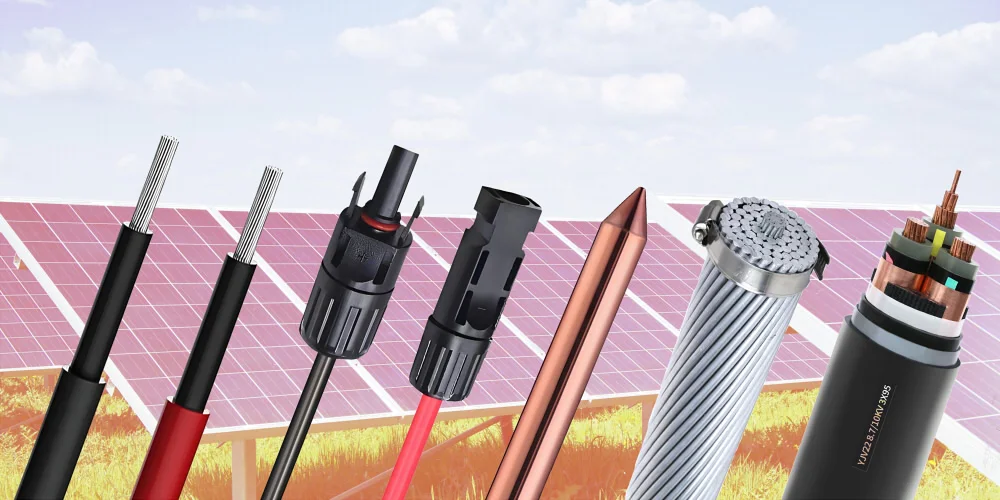
Күн тұрақты ток кабелі
Бұл кабельдер фотоэлектрлік модульдерді қосу үшін арнайы жасалған (Күн панельдері) және модульдер арасындағы электрмен жабдықтау үшін DC Combiner қорабы үшін. Олардың сыртқы ортаға тікелей әсерін ескере отырып, Олар келесі сипаттамаларға ие болуы керек:
- Ультракүлгінге төзімділік: Ұзақ уақытқа созылған әсердің нашарлауын болдырмау үшін.
- Ауа-райы кедергісі: Ауа-райының әртүрлі жағдайларына төтеп беру, соның ішінде тым температура, ылғалдық, және жел соғылған құм.
- Тұз спрейі коррозияға төзімділігі: Тұздың зақымдануын болдырмас үшін жағалаудағы жерлерге жарамды.
- Жалынның бұзылуы: Өрт қаупін азайту және жүйенің қауіпсіздігін арттыру.
- Механикалық беріктік: Орнату және қоршаған ортаға оңай зақымдалмай-ақ төзімді.
Айнымалы ток кабелі
Айнымалы ток сымдары инвертордың шығу нүктесінде түрлендірілген айнымалы ток қуатын айнымалы ток көзіне айнымалы ток тарату тақтасына немесе тікелей торға жіберу үшін қолданылады. Бұл кабельдер желілік байланыс стандарттарына сәйкес келуі керек және қауіпсіз және тиімді қуат беру үшін жақсы оқшаулау қасиеттері мен жылу кедергісі болуы керек.
Деректермен байланыс кабелі
Күн энергиясын өндіру жүйесінде, Деректермен байланыс кабельдері ақпараттық көпір ретінде әрекет етеді. Олар фотоэлектрлік массивпен жасалған электрлік деректерді ғана өткізіп қана қоймай, инверторлардың және басқа бақылау жабдықтарының нақты уақыттағы жағдайы туралы ақпаратты сымды немесе сымсыз желілер арқылы орталық бақылау жүйесіне жеткізеді (соның ішінде талшықты оптика) Жүйені оңтайландыру және ақаулық диагностикасы үшін.
Басқару кабелі
Басқару кабельдері контроллерлерді қосу үшін қолданылады, инверторлар, және жүйедегі басқа да қосалқы жабдықтар, Автоматтандырылған бақылау және тиімді бақылауды қамтамасыз ету. Бұл кабельдерде сигнал берудің жақсы тұрақтылығы және бақылау пәрмендерінің дәл орындалуын қамтамасыз ету үшін жақсы сигнал беру керек.
Жерге қосу кабелі
Жерлендірілген кабельдер бүкіл күн энергиясын өндіру жүйесінің қауіпсіздігін қорғауда маңызды рөл атқарады. Олар найзағай ағындарын немесе жүйелік ақауларды тез зарядтау үшін төмен төзімді жолды қамтамасыз етеді, Электр тогының соғуы және жабдықтардың зақымдануын болдырмау, Осылайша, кадрлар мен жабдықтардың қауіпсіздігін қамтамасыз ету.
Үстеме кабель
Белгілі бір орнату сценарийлерінде, мысалы, алыс қашықтықтан тарату немесе рельефтік шектеулер, Күн қуатын өндіру жүйесінің торды қосу үшін үстеме кабельдер қолданылады. Бұл кабельдер жақсы өткізгіштік пен механикалық беріктігін сақтау кезінде сыртқы физикалық зақымдану мен климаттық факторларға қарсы тұру керек.
Бұл күн кабельдерін таңдағанда, Олардың сипаттамаларын және қолданыстағы орталарын қарастыру ғана емес, сонымен қатар барлық кабельдер мен аксессуарлардың ұзақ мерзімді тұрақты жұмысын және күн энергиясын өндіру жүйесінің сақталуын қамтамасыз ету үшін жергілікті электр қауіпсіздігі стандарттары мен салалық ережелерге сәйкестігін қамтамасыз ету өте маңызды..
Фотоэлектрлік электр станциясында құрылыстың жалпы құнының қанша пайызын құрайды?
Фотоэлектрлік кабельдердің құны (Пв) Электр станциясы әдетте айналасында болады 10% Құрылыстың жалпы құнының. Бұл пайыз жобаның ауқымы сияқты бірнеше факторларға байланысты өзгеруі мүмкін, Жабдықты таңдау, Аймақтық айырмашылықтар, және нарықтағы ауытқулар. Кейбір бағалаулар бойынша:
- Фотоэлектрлік модульдер (Күн панельдері) Шоу үшін есептік жазба 50% Жабдықтың жалпы құны.
- Инверторлар және басқа электр жабдықтары туралы есеп 10%.
- Кабельдер мен монтаждау құрылымдары әр шот айналасында 10%.
Сондықтан, Әдетте кабель шығындары 10% Құрылыстың жалпы құнының. Дегенмен, Бұл өрескел баға, және нақты пропорция жобаның нақты бюджеті мен материалдық бағасына байланысты өзгеруі мүмкін. Қосымша, Технологиялар мен нарықтық өзгерістермен, Бұл пайызға түзетулер енгізілуі мүмкін.
Күн дК кабельдері туралы
Неліктен фотоэлектрлік жүйелер үшін арнайы кабельдерді қолдану?
Фотоэлектрлік кабельдер фотоэлектрлік электр қуатын өндіру жобаларына арналған, Қарапайым кабельдердің оқшауланған және қабықпен сипаттамаларымен.
Егер қарапайым кабельдер PV жүйесінде пайдаланылса, Олар ашық жерде қатал ортада сәтсіздікке бейім, бүкіл күн энергетикалық жүйесінің қызмет ету мерзімін едәуір төмендетеді. Қосымша, Бұл ағымдағы шамадан тыс жүктемеге әкелуі мүмкін, қатты кернеудің төмендеуі, Жиі буынның ақаулары, Фотоэлектрлік электр станцияларындағы төмен буын тиімділігі, Тіпті өсімдікке өрт шығуы мүмкін.
Сондықтан, Фотоолтаикалық электр станцияларының ұзақ мерзімді тұрақты жұмысын қамтамасыз ету 25 жылдар, Фотоэлектрлік жүйелер үшін арнайы жасалған кабельдерді таңдау қажет, мысалы, H1Z2Z2-K немесе Pv1-F.
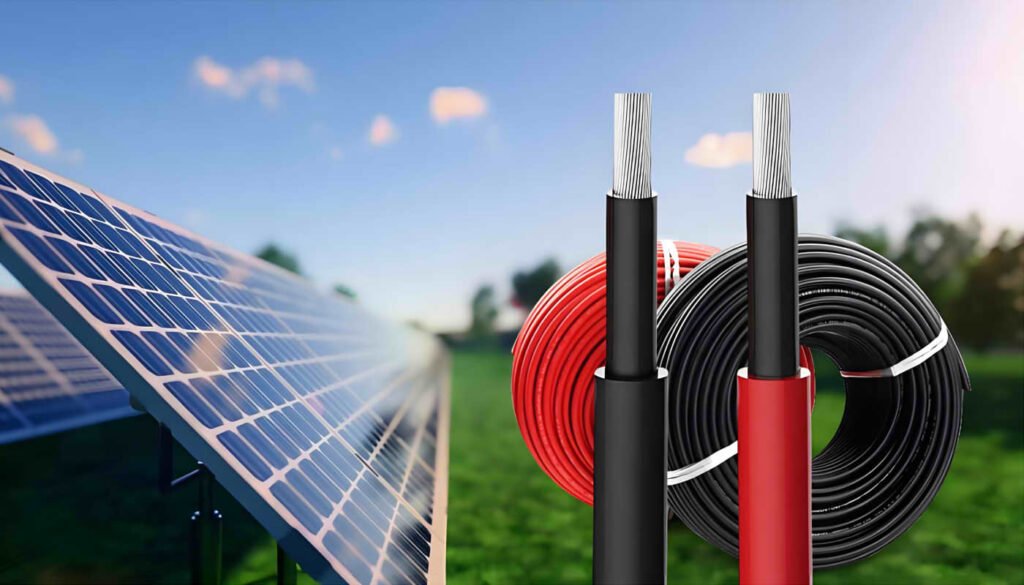
Күннің кабельдеріне арналған TÜV сертификаты қандай?
TÜV күн кабелінің сертификатталуы тексерілген кабельдермен марапатталған сертификаттарға жатады, TÜV Rheinland Group компаниясының тәуелсіз үшінші тарапы тексеріп, сертификатталған, штаб-пәтері Германияда, Нақты стандарттарға сәйкес.
Кабельдің арнайы түрі ретінде, Фотоэлектрлік кабельдердің қауіпсіздігі мен өнімділігі күн энергиясын өндіру жүйелері үшін өте маңызды, Сондықтан олар олардың сапасы мен сенімділігін қамтамасыз ету үшін қатаң сынақ және сертификаттаудан өтеді.
PV кабельдеріне арналған TÜV сертификатына қатысты, Оның дамуы 2-ші деңгейден өтті 1169/08.2007 en-ге стандарт 50618:2014 стандарт. Ең соңғы стандарт - IEC FDI 62930, Бірақ күн сәулесінің сергектері әлі де жарамды EN-ге сәйкес келеді 50618 стандарт.
H1ZZ2Z2-K PV кабельдер үшін қандай сипаттамаларды таңдау керек?
Типтік фотоэлектрлік жүйелерде, Ең көп таралған нұсқалар - H1Z2Z2-K 1×4 және h1z2z2-k 1×6 Кабельдер. Жалпы, Үлкенірек кабельдің көлденең қималары үлкен жүктеме мүмкіндіктерін көрсетеді.
Жұмыс кернеуі сияқты пікірлер, Ағымдағы сыйымдылық, және қоршаған орта температурасының диапазоны да айтылуы керек. Кернеу мен ағымдағы талаптарды анықтағаннан кейін, Тиісті сипаттаманы таңдау үшін H1Z2Z2-K кабельдерінің параметр кестесін қараңыз.
Егер сіз кабель сипаттамаларын таңдауда белгісіздікке тап болсаңыз, Біздің ЗМК техникалық тобы арнайы шешімдерді ұсынуға қол жетімді.
Толығырақ біліңіз H1Z2Z2-K Solar кабелі
H1Z2Z2-K Photovollaic кабельдерінің DC және AC қосымшалары арасындағы айырмашылықтар қандай??
H1Z2Z2-K кабельдер де DC тізбектері үшін пайдалануға болады (1.5кВ) және айнымалы ток тізбектері (1.0/1.0кВ). Photovoltaic Power gucy instructions, олардың нақты қосымшаларының айырмашылықтары келесідей:
DC қосымшалары үшін:
- Фотоэлектрлік модульдер арасындағы байланыс
- Жолдар арасындағы параллель байланыс
- DC тарату қораптарына қатардан параллель байланыс
- Тұрақты тарату қораптарынан инверторларға қосылу
Айнымалы қосымшалар үшін:
- Инверторлардан бастап трансформаторларға қосылу
- Күту трансформаторларынан тарату құрылғыларына қосу
- Тарату құрылғыларынан торға немесе пайдаланушыларға қосылу
H1z2z2-K және Pv1-F PV1-F фотоэлектрлік кабельдер арасындағы айырмашылықтар қандай??
Pv1-F кабелі - бұл TÜV 2PFG1169 стандартына сәйкес келетін ескі нұсқаның келі, Оның стандартты сертификаты жаңартылуды тоқтатады. Қайта, H1Z2Z2-K Photovollaic кабелі TÜV EN50618 соңғы нұсқаларына сәйкес келеді:2014 куәлік.
ВВ1-F және H1Z2Z2-K сымдары арасында кернеу рейтингі әртүрлі. Pv1-F DC кернеу рейтингі бар: 1.0кВ және айнымалы ток: Uo / u: 0.6/1.0кВ, H1Z2Z2-K кернеудің тұрақты рейтингі бар: 1.5кВ және айнымалы ток: Uo / u: 1.0/1.0кВ. H1Z2Z2-K жоғары беріліс тиімділігі мен тұрақтылықты қамтамасыз ете алады.
Құрылым бойынша, Pv1-F кабелінде бір оқшауланған қабат бар, Ал H1Z2Z2-K кабелі қос қабатты оқшаулау құрылымын қабылдайды. Бұл H1Z2Z2-K кабелін беріктігі мен қорғауға арналған, Әсіресе механикалық зақымдану және қоршаған орта факторлары.
Қысқаша, H1Z2Z2-K Solar кабелі дизайнда жетілдірілген, Электр және механикалық қойылым жоғары, Қосымша талап етілетін орталар үшін қолайлы. Басқа жақтан, Pv1-F Solar кабелі ең алдымен шығындар тиімділігіндегі тиімді, Көптеген дәстүрлі фотоэлектрлік жүйелер үшін қолайлы.
Шығындар тиімділігі туралы пікірлер үшін, Pv1-F кабелін Photovoltaic модульдері мен Parlel қосылымдар арасындағы сериялы қосылымдар үшін және DC тарату терезелеріне параллель қосылымдар арасында пайдалануға болады. Сол уақытта, H1Z2Z2-K кабелін тарату қораптары мен инверторлар арасындағы байланыстар үшін пайдалануға болады, сонымен қатар ірі инверторларда тікелей ағымдағы қосылыстар үшін.
Pv1-F кабельдік сипаттамасын қалай таңдауға болады?
Ағымдағы сәтте, Ең жиі қолданылатын фотоэлектрлік тұрақты ток кабелі - PV1-F 1×4 кабель. Дегенмен, Фотоэлектрлік модуль токтарының жоғарылауымен және біріктірілген қуаттылығы, Pv1-F 1 қосымшасы×6 DC кабельдері де артып келеді.
Тиісті сипаттамаларға сәйкес, Жалпы, фотоэлектрлік тұрақты ток желілерінің жоғалуы ұсынылады 2%. DC тізбектерінде, Pv1-F 1x4MM² сымына төзімділік 4,6 метр / м құрайды, Pv1-F 1x6MM² сымына төзімділік 3,1мω / м. DC модульдері үшін 600 В жұмыс кернеуін қабылдау, а 2% Кернеудің төмендеуі - 12 В. 13А модульді қабылдау, 4MMM к кабелін пайдалану кезінде, Инверторға ең төменгі модульдің ұштарынан алынған максималды қашықтықта инвертордан аспауы керек 120 Есептегіштер (бір жол, Оң және теріс тіректерді қоспағанда). Егер ол осы қашықтықтан асып кетсе, 6MMM DC кабелін таңдау ұсынылады, Бірақ инверторға ең алыс модульдің ұшынан ұсынылған максималды қашықтық аспауы керек 170 Есептегіштер.
Жүйелік шығындарды азайту, Photovoltaic электр станциялары қазір модульдер мен инверторларды сирек конфигурациялайды 1:1 пропорция. Орнына, Олар күн сәулесінің шарттары мен жобалық талаптары сияқты факторларға байланысты белгілі бір мөлшерді жобалайды. Мысалы, 110 кВт модулі үшін, 100 кВт инверторы таңдалған, Бұл инвертордың ток жағындағы 1.1x-тің артықшылығы негізінде есептеледі. Айнымалы ток шығарудың максималды тогы шамамен 158а құрайды. Апрофондар инвертордың максималды шығыс тогына байланысты таңдалады. Себебі модульдердің қаншалықты артық екеніне қарамастан, Инвертордың айнымалы ток əнші инвертордың шығысы ешқашан аспауы керек.
Толығырақ біліңіз Pv1-F Solar кабелі
Күндер неге қызыл және қара түске бөлінеді??
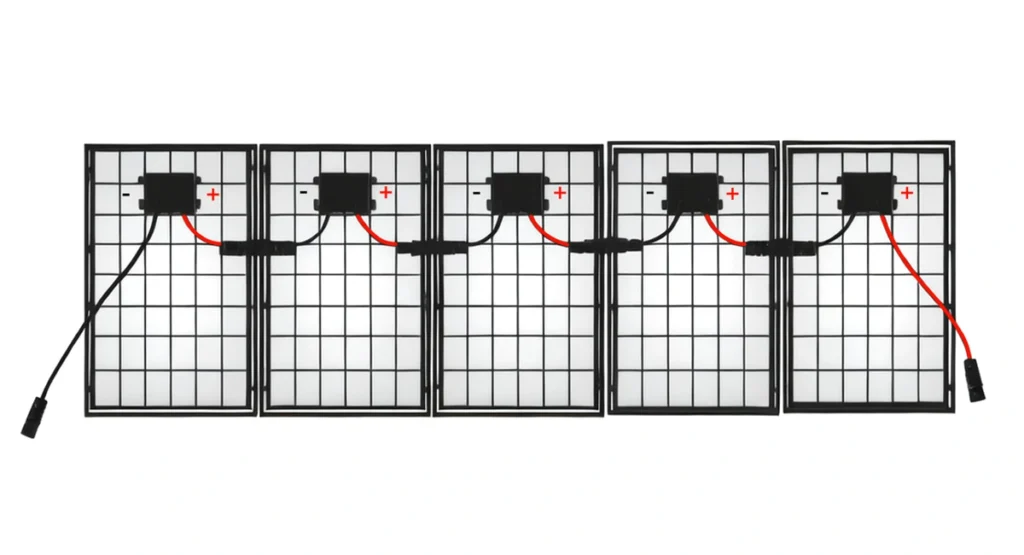
Фотоэлектрлік өнеркәсіпте, Қызыл және қара кабельдерді пайдалану кеңінен қабылданған сәйкестендіру әдісіне айналды. Олардың негізгі мақсаты - оң және теріс тіректерді ажырату. DC тізбектерінде, әдетте, Қызыл күн сымдары токтың оң полюсін көрсетеді, Қара күн сымдары теріс полюсті көрсетеді. Бұл түсті саралау күн жүйелерін орнату және техникалық қызмет көрсету кезінде фотоэлектрлік қосылыстардың полярлығын тез анықтауға көмектеседі, Осылайша, сымдар қателерінің алдын алу.
Күн кабелінің қосқыштарын өзіңіз жасай аласыз ба??
Күн кабелінің қосқыштарын жасау процесі ерлер мен әйелдердің өзектері мен бастарының зақымдалуын тексеруді қамтиды, және сым сызғыштарды пайдалану, сығу құралдары, және ашық кілттер. Тіпті кәсіпқой емес адамдар бұл қосқыштарды арнайы қадамдарды орындау арқылы жасай алады.
Коннекторларды өзіңіз жасаумен салыстырғанда, күн панелінің ұзартқыш кабельдерін тікелей теңшеу сәл қымбатырақ болуы мүмкін, бірақ ол уақыт пен еңбекті үнемдей алады және орнатуды ыңғайлы етеді.
Жиі қолданылатын күн қосқыштары дегеніміз не?
Күн фотоэлектрлік жүйелерінде ең жиі қолданылатын қосқыш түрі MC4 қосқышы болып табылады. Ол кең таралған және нарықта танылуына байланысты фотоэлектрлік қосқыштар үшін стандарттардың біріне айналды.. MC4 қосқышының ұзартқыш кабельдері жоғары кернеу мен токқа төтеп бере алады және күн панельдерін қосу үшін жарамды, инверторлар, және басқа жүйе құрамдастары.
ZMS MC4 үйлесімді қосқыштары техникалық сипаттамалардағы MC4 қосқыштарына сәйкес келеді, өлшемі, және төзімділік және болуы мүмкін 100% сәйкес келді.
MC4 қосқыштарына қосымша, басқа жиі қолданылатын күн қосқыштарына Y-типті немесе параллель қосқыштар жатады. Олардың құрылымы бір-көп қосқышы болып табылады, токты тұрақты түрде сақтай отырып, бүкіл панель массивінің кернеуін арттыру үшін бірнеше күн панельдерін тізбектей қосуға болады.
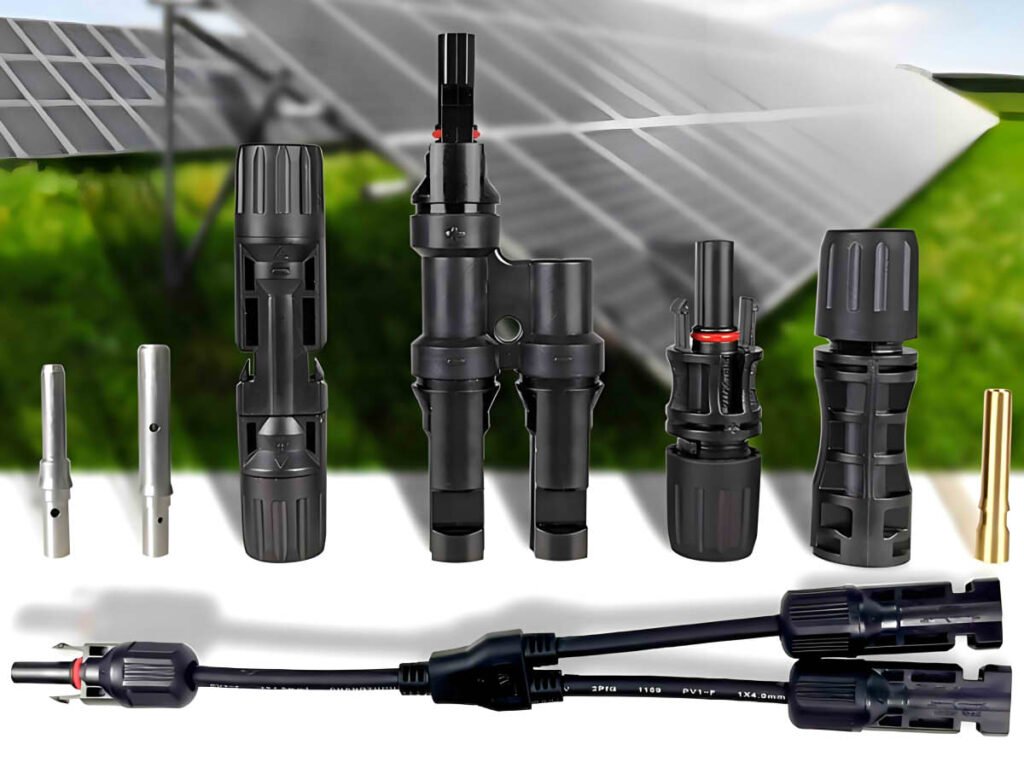
Толығырақ біліңіз Күн кабель коннекторы
Күндік айнымалы ток сымдары туралы
Күн қуат көздері үшін AC LV кабельдері қалай таңдалуы керек?
Күн электр станциясы жүк ортасына жақын болған кезде немесе өзі таратылған ұрпақ болып табылады, Сізге үш фазалы 400V немесе бір фазалы 230В төмен вольтты тарату желісіне тікелей қосылу үшін төмен вольтты кабельдерді пайдалану керек. Орташа немесе жоғары вольтты торға қосылу үшін, Төмен вольтты кабельдерді алдымен трансформаторға қосылу үшін пайдаланылуы керек.
Инвертордың ток кернеуі әдетте әртүрлі стандарттарда келеді. Мысалы, Орталық инвертордың шығу кернеуі 315 В болуы мүмкін, 360В, 400В, және т.б., Жол инверторының шығу кернеуі 480 В болуы мүмкін, 500В, 540В, 800В, және т.б..
Сондықтан, PV жүйелерінде, Төмен вольтты кабельдерді 450/750 В кернеулі кернеуді пайдалануға болады, 0.6/1 кВ, немесе 1.8/3 кВ. Кабельдің көмілгеніне немесе қойылмағанына байланысты, Бронетранген қабат қосуға болады.
Толығырақ біліңіз Айнымалы ток күн кабелі
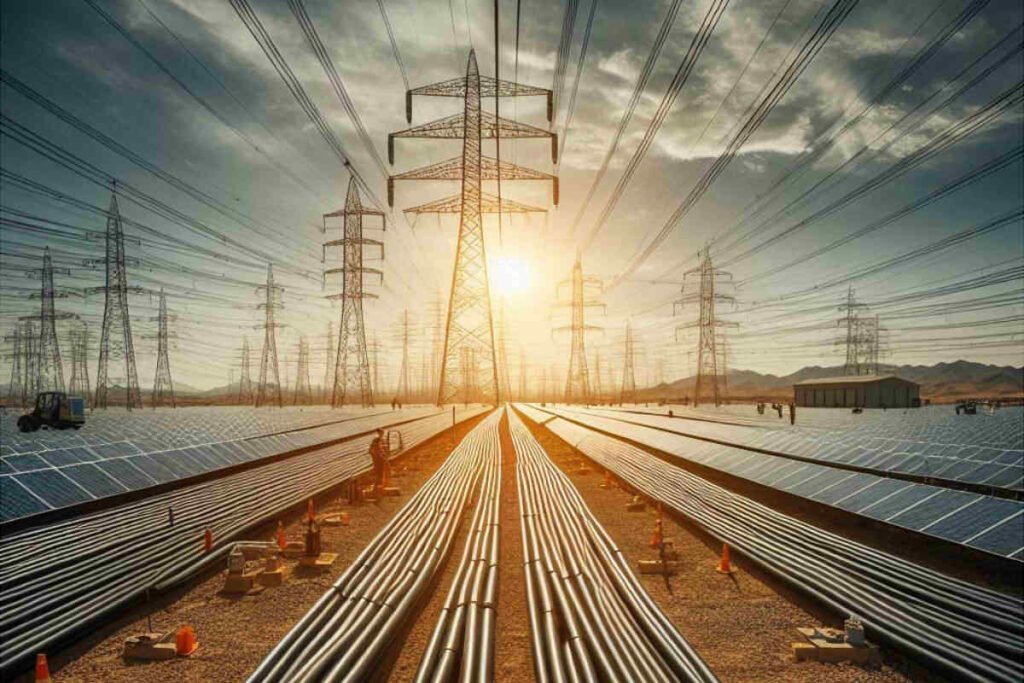
Күн қуатымен жобалар үшін айнымалы ток сымдары қалай таңдалуы керек?
Егер Photovoltaic Power генерациясы жүйесі орташа немесе жоғары вольтты торға қосылуы керек болса, Төмен вольтты кабельдерді алдымен трансформаторға қосылу үшін пайдаланылуы керек, ол кернеуді тиісті деңгейге көтереді. Орташа кернеудің кабельдері қосалқы станцияға қуат алу үшін қолданылады. Орташа кернеудің кабельдерінің саны міндетті түрде қосылу әдісіне байланысты.
Дәстүрлі жұлдыз құрылымы
Дәстүрлі жұлдыз құрылымында, Әр трансформаторда қосалқы станцияға қосылған бірыңғай орташа кернеудің шығу сызығы бар. Бұл құрылым қарапайым және қарапайым, Бұл жиі фотоэлектрлік электр станцияларының дизайнында қолданылады. Әр кабель тек бір трансформатордың қуатын алады, сондықтан кабель сипаттамалары кішірек, Шығындарды азайту. Дегенмен, Әр трансформатордың қосалқы станцияға қосылатын бір жолы бар болғандықтан, Сенімділік өте жоғары емес.
Бір шығыс сақинасының құрылымы
Бір розеткаға арналған қоңырау құрылымы Сабельдерді қолданып сақинаның бірнеше трансформаторларын қосады, және қосалқы станцияға жақын трансформатор қосалқы станцияға орташа кернеулі кабельдерді қолданып қосылған. Қос шығыс сақинасының құрылымымен салыстырғанда, Бір шығыс сақинасының құрылымы азырақ кернеулі айнымалы ток сымдарын пайдаланады. Дегенмен, Себебі бүкіл сақинаның қосалқы станцияға қосылатын бір жолы бар, Сенімділік төмен.
Екі шығыс сақинаның құрылымы
Қос шығыс сақиналық құрылымда бір шығыс сақинасының құрылымымен салыстырғанда қоңырауды қосалқы станцияға қосатын қосымша желі бар. Егер бір шығыс сызығы істен шықса, Қалған сызық инверторларға рингтің инверторларға торға қуат беруіне мүмкіндік беруі мүмкін. Бір шығыс сақинасының құрылымына ұқсас, Ақаулық кезінде ағын бағытын ескере отырып, Барлық кабельдердің барлық трансформаторлардың күшін төгу үшін таңдалуы керек, нәтижесінде салыстырмалы түрде жоғары шығындар пайда болады.
Көпір құрылымы
Сақинаның құрылымы ұсынылғанға дейін, Көпір құрылымы жиі қолданылады. Бұл құрылымда, Жұлдыздың құрылымына негізделген, Көршілес трансформаторлардың әр жұбы орташа кернеулі кабельдер көмегімен қосылады. Бұл жолмен, Әр трансформатордың қосалқы станцияға қосылатын екі жолы бар, жүйенің сенімділігін арттыру. Дегенмен, Трансформаторлардың әр жұптары арасындағы қосымша кабельдерге байланысты шығындар салыстырмалы түрде жоғары.
Әр түрлі мөлшердегі фотоэлектрлік электр станциялары үшін, Кабельді таңдау талдауы әртүрлі талаптарға сәйкес өзгереді. Орташа вольтты кабельдерді таңдағанда, Міндетті талаптарды жан-жақты қарастыру қажет, шығындары, және ең тиімді шешім мен шешімді анықтаудың артықшылықтары.
Күн энергиясы жүйелеріне арналған айнымалы ток кабельдерін таңдаудың қандай принциптері бар?
Күн жобаларына арналған айнымалы ток кабельдерін таңдау кабельді таңдауға қойылатын жалпы талаптарды ұстанады, кернеу деңгейін ескере отырып, Үздіксіз жұмыс, Қысқа тұйықталу жылу тұрақтылығы, Рұқсат етілетін кернеудің төмендеуі, Экономикалық токтың тығыздығы, және орнату ортасының шарттары. Қосымша, Photovoltaic Power grouction өзінің сипаттамалары бар, Жоғары температура сияқты қатал экологиялық жағдайда қолдануға болатын кабельдерді қарауды талап етеді, қатты суық, және ультракүлгін сәулелену. Сондықтан, Келесі факторларды ескеру қажет:
- Кабельді оқшаулау
- Кабельдің жылу кедергісі және жалынның құлдырауы
- Ылғалға төзімділік және кабельді ультракүлгін қорғау
- Кабельді орнату әдістері
- Кабельдік өткізгіш түрі
- Кабель сипаттамалары
Жерге қосу жүйесіне арналған кабельдер туралы
Неліктен күн энергиясын өндіру жүйелерін жерге қосу керек?
PV жүйелеріндегі жерге тұйықтау PV орнату қызметкерлері жиі назардан тыс қалдыратын мәселелердің бірі болып табылады, әсіресе жерге қосу және найзағайдан қорғауға көп көңіл бөлінбейтін шағын қуатты PV жүйелерінде.
Дегенмен, жерге қосу орындалмаса, қателер оқшаулаудың жерге төзімділігінің төмендігінен немесе шамадан тыс ағып кету токтарынан туындауы мүмкін, электр энергиясын өндіруге әсер етеді және жеке қауіпсіздікке қауіп төндіреді. Қосымша, қорғалмаған немесе жоғары көтерілген металл бөлшектер найзағай соққыларына көбірек бейім. Жерге қосусыз, жабдықты найзағай соғуы мүмкін, PV электр энергиясын өндіру жүйесіне айтарлықтай зиян келтіреді.
PV жүйелеріндегі жерге тұйықтау негізінен күн компоненті жағында жерге қосуды қамтиды, инвертор жағы, және тарату шкафының жағы. Дұрыс жерге қосу күн жүйесінің қауіпсіздігін арттырып қана қоймай, оның қызмет ету мерзімін де ұзартады.
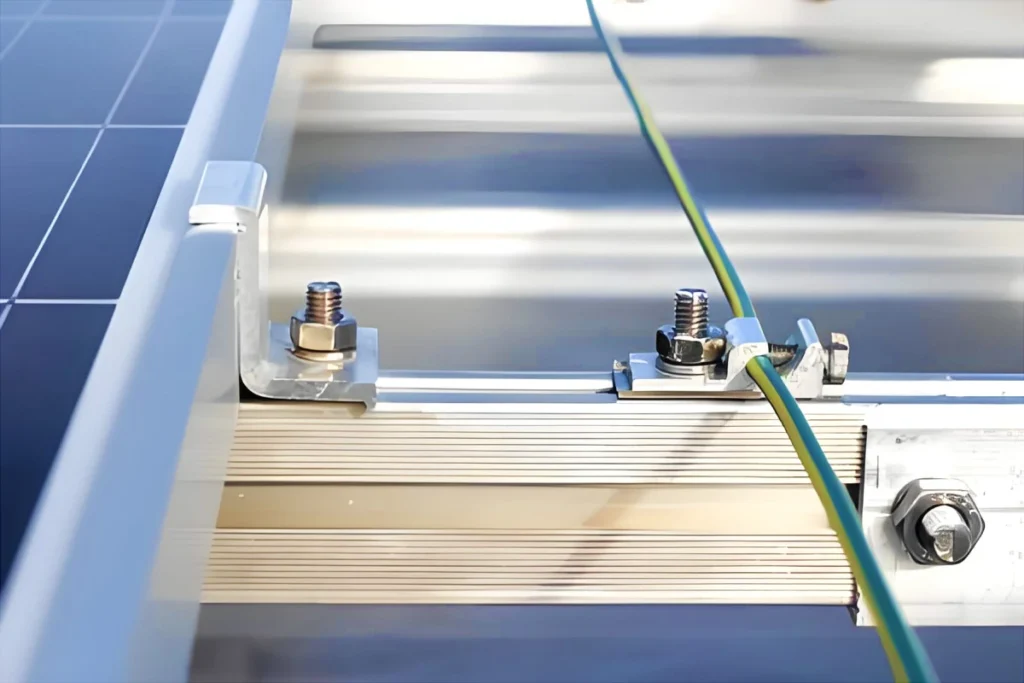
Күн энергиясы жүйелерінде қандай жерге қосу қажет?
Құрамдас жағындағы жерге қосу:
- Модуль жақтауын жерге қосу: Монтажға жанасатын модульдің алюминий жақтауы тиімді жерге қосуды білдірмейді. Тиімді жерге қосу үшін модульдің жерге қосу тесігі монтажға қосылуы керек. Модульдердің жерге қосу саңылаулары әдетте жолдық қосылымдар үшін пайдаланылады, екі шетіндегі жерге тұйықтау саңылаулары металл тірекке жалғанған.
- Жерге қосу: Әдетте, дөңгелек болат, мырышталған болат шыбықтар, немесе жерге қосу үшін мыс қосылған болат шыбықтар қолданылады, жерге тұйықтау кедергісі 4 Ом аспауы керек.
Инверторлық жерге қосу:
- Операциялық жерге қосу: Инвертордың PE терминалы тарату қорабындағы PE шинасына қосылған, тарату қорабы арқылы жерге тұйықталған.
- Қорғаныс жерге тұйықтау: Инвертор шассиінің жерге қосу тесігі инверторды және операторлардың қауіпсіздігін қорғау үшін қайталап жерге тұйықтау үшін пайдаланылады.. Инвертор шассиінің қорғаныш жерге тұйықталуы бөлек жерге тұйықтау электродты пайдалана алады немесе біреуін тарату қорабымен бөлісе алады..
Тарату қорапшасының жерлендіруі:
- Найзағайдан қорғайтын жерге қосу: Айнымалы токтың найзағайдан қорғауы сақтандырғыштардан немесе автоматты ажыратқыштардан және асқын кернеуден қорғау құрылғыларынан тұрады (SPD). SPD төменгі ұшы тарату қорабының жерге қосу шинасына қосылған.
- Қорапты жерге қосу: Ережеге сәйкес, тарату қорапшасының металл жақтауы мен негізгі болаты жерге тұйықталуы немесе бейтарапқа қосылуы керек. Шкафтың есігі мен корпусының сенімді жерге тұйықталуын қамтамасыз ету үшін көлденең қосылым қажет.
Күн панельдері қалай жерге тұйықталған?
Жалпы, күн панельдеріндегі жерге қосу саңылаулары панельдердің қатарларын қосу үшін пайдаланылады. Жіптің екі шетіндегі панельдер металл жақтауға қосылған, негізінен сары-жасыл күн жер кабельдерін пайдалану.
Панель жақтауларын жерге қосу үшін, әдетте φ10 немесе φ12 мыс байланыстырылған болат шыбықтар қолданылады, жерленген 1.5 метр жер астында.
Күн батареяларының жерге тұйықталу кедергісі 4 Ом аспауы керек. Жерге қосу кедергісі талаптары орындалмаса, әдетте қарсылықты төмендететін заттар қосылады, немесе жерге тұйықтау штангалары топырақтың меншікті кедергісі төмен жерлерде көміледі.
Толығырақ біліңіз Күндесетін кабель
Неліктен күн панельдерінің жақтауларын қосу және жерге қосу керек?
Кейбір адамдар күн панельдері де, олардың тірек құрылымдары да металл деп санайды, тек тіректерді жерге қосу жеткілікті.
Шындығында, күн панелінің алюминий жақтауларының көпшілігі және мырышталған немесе алюминий қорытпаларының тіректері қапталған, ол жерге қосу талаптарына сәйкес келмейді. Қосымша, күн панельдері уақыт өте келе ескіруі мүмкін, шамадан тыс ағып кетуге немесе жерге оқшаулаудың төмен кедергісіне әкелуі мүмкін. Егер күн панелінің жақтаулары жерге тұйықталмаса, пайдалану мерзімінен кейін, бұл инвертордың істен шығуына әкелуі мүмкін, PV жүйесінің электр энергиясын дұрыс өндіруіне жол бермеу.
Күн батареяларының жақтауларын металл тіректерге жалғау кезінде, жерге тұйықтау кедергісін азайту үшін металл беттерінен оксид қабатын алып тастау қажет, жерлендіру талаптарына сәйкестігін қамтамасыз ету.
Фотоэлектрлік жүйелердегі өзектерді жерге қосу үшін қандай материалды қолдану керек?
Мырышталған болат арзанырақ, бірақ оның дәнекерленген қосылыстары көп, нәтижесінде құрылыс тиімділігі төмендейді және құрылыс құны жоғарылайды. Таза мыс тамаша өткізгіштікке ие, бірақ қымбат. Мыспен байланысқан болат, дегенмен, тек шығындар 9.4% мырышталған болаттан артық және әлдеқайда ұзағырақ қызмет ету мерзімін ұсынады. Сондықтан, мыс байланыстырылған болат электр жерге таяқшалар әдетте күн энергиясы жүйелерінде негізгі жерге тұйықтау материалы ретінде таңдалады..
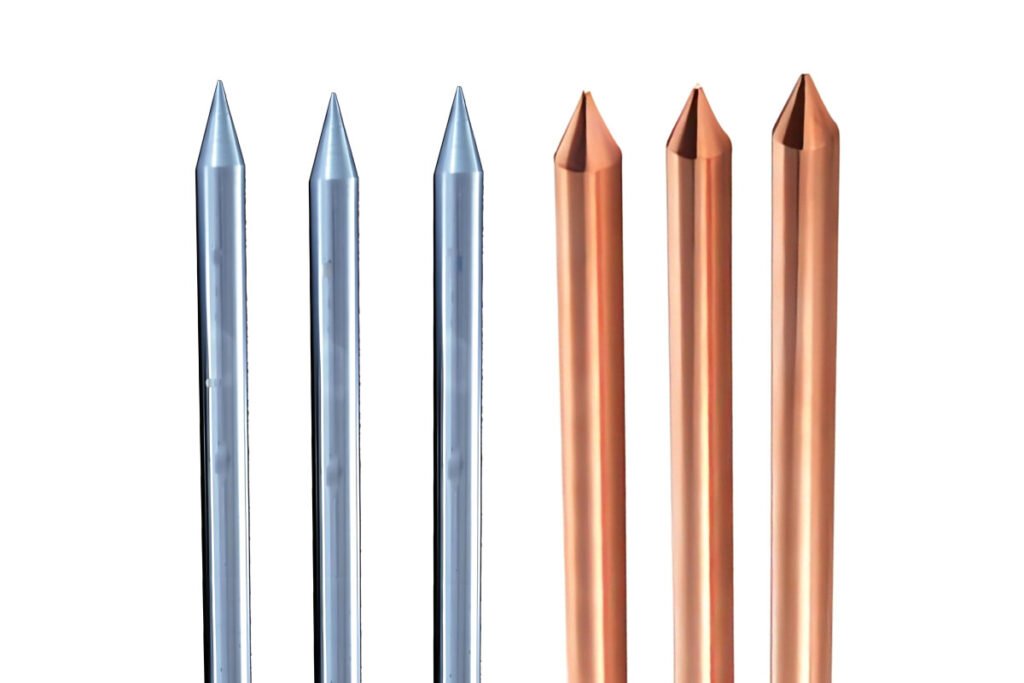
Жер таяқшаларының қандай техникалық сипаттамалары жиі пайдаланылады?
Мыспен байланысқан болат
Фотоэлектрлік қуат жүйелерінде, мыс байланыстырылған болат жерге тұйықтау материалдарының көлденең жерге тұйықтау корпусы әдетте Φ10-Φ12 мыс байланыстырылған дөңгелек болатты пайдаланады., әдетте өндірістік ұзындығымен 100 бір катушка метр. Жерге қосу электродтары Φ14 немесе Φ17.2 мыс байланысқан болат өзектерді пайдаланады.
Қосылу әдісі: Термиттік дәнекерлеу (сыртқы қуат немесе ацетилен қажет емес), бірлескен материалдар үшін таза мысты пайдалану, дәнекерлеу орындарында коррозияға қарсы шараларды қажет етпей.
Мырышталған болат
Дәстүрлі жерге қосу торларында, Ыстық мырышталған болаттан жасалған көлденең жерге тұйықтау корпустары әдетте 50X5 немесе 60X6 мырышталған жалпақ болаттан жасалған., өндірістік ұзындығымен 6 бір бөлікке метр. Тік жерге қосу электродтары 50X5 ыстық мырышталған бұрышты болат немесе Φ50 мырышталған болат құбырларды пайдаланады., жерлендіру электродының ұзындығымен 2.5 бір бөлікке метр.
Қосылу әдісі: Электр дәнекерлеу, коррозияға қарсы өңдеуді қажет ететін дәнекерлеу нүктелерімен, мысалы, тоттануға қарсы бояудың екі қабаты және асфальт бояуының бір қабаты.
Жалаңаш мыс
Таза мыс жерге тұйықтау материалдары үшін, көлденең жерге қосу корпусы әдетте 25 пайдаланады×4, 40×4, 50×5, немесе 60×6 мм мыс жолақтар, немесе S70/S95/S120/S150/S185/S240 мм жалаңаш мыс сымдар. Тік жерге қосу корпусы әдетте 16 пайдаланады×2500 мм немесе 20×2500 мм мыс шыбықтар, немесе 50×3000 мм немесе 55×2500 мм таза мыс электролиттік ионды жерге қосу электродтары.
Қосылу әдісі: Термиттік дәнекерлеу, отты балшықты балқыту дәнекерлеу, немесе ыстық балқымамен пісіру.
Толығырақ біліңіз PV жүйесі үшін жер үсті
Фотоэлектрлік жүйелерде жер таяқшаларын қалай орнату керек?
Құрылыс кезінде, жерге таяқшаны орнату өте икемді және оны сайттағы нақты жағдайларға бейімдеуге болады. Әртүрлі әдістерді қолдануға болады, мысалы, ауыр балғалармен немесе электрлік балғалармен топыраққа электрлік жердегі өзектерді тікелей айдау. Таяқшаны айдауға болмайтын күрделі топырақ жағдайында, жерге таяқшаны орнатпас бұрын алдымен тесікті бұрғылауға болады.
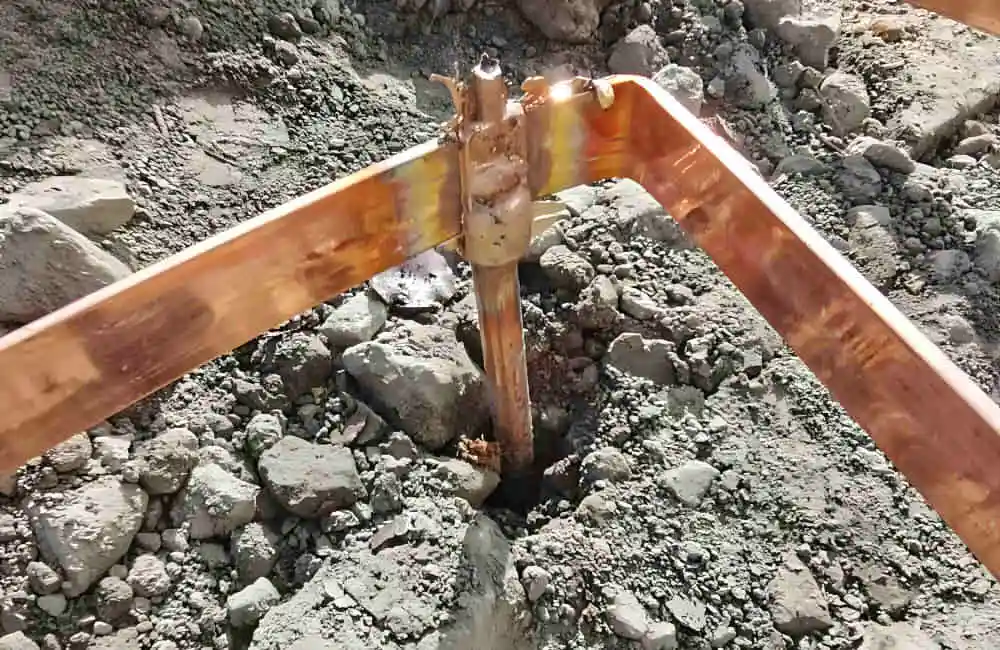
Біркелкі топырақ жағдайында, орнату үшін ауыр балға қолданылса және бір шыбықты жүргізсе, бұрғылауды орнатқан жөн (соққыға төзімді болт) стерженьді терең айдаған кезде мыс қабатының зақымдалуын болдырмау үшін штанганың сүйір ұшында. Тереңірек жерге қосу үшін, қалаған ұзындыққа қол жеткізу үшін қосқыштар арқылы бірнеше шыбықтар қосылуы мүмкін, жақсы электр байланысын қамтамасыз ету.
Терең бұрғылау қиын немесе мүмкін емес жағдайларда, бұрғылау құралдарын тау жыныстарын тесіп өту үшін пайдалануға болады. Бұрғылаудан кейін, жерге таяқтарды орнатудың екі әдісі бар:
- Коннекторларды пайдаланып штангаларды қажетті ұзындыққа қосыңыз. Бір рет жоспарланған тереңдікке дейін бұрғылау, саңылауды кедергіні төмендететін затпен толтырыңыз және тесік толтырылғанша су қосыңыз.
- Коннекторларды пайдаланып штангаларды қажетті ұзындыққа қосыңыз. Белгіленген тереңдікке дейін бұрғылаудан кейін, кедергіні төмендететін агентті сумен араластырыңыз және таяқшаны толығымен жабу үшін оны тесікке құйыңыз.
Үстеме кабельдер, Бақылау кабельдері және PV жобаларындағы байланыс кабельдері
Күн энергиясы жүйелерінде қандай қосымша кабельді қолдану керек?
Қосылған фотоэлектрлік электр энергиясын өндіру жүйелерінде, Жасалған тұрақты ток қуаты инвертордың айнымалы ток көзіне ауыстырылып, айнымалы ток торына біріктірілген, Электр энергиясын беру көбінесе үстеме сызықтар арқылы жүзеге асырылады. Әдетте, Photovoltaic Power guce guce жүйелерінің желілік байланысы келесі сценарийлерде пайда болуы мүмкін:
Тікелей қосылу
Кіші таратылған фотоэлектрлік электр энергиясын өндіру жүйелері үшін, мысалы, тұрғын үйдің фотоэлектроттері, Тұрақты ток қуатын тікелей инвертор арқылы айнымалы ток көзіне айналдыруға болады, содан кейін Тарату сызықтары арқылы төмен вольтты торға қосылады. Бұл жағдайда, Жерасты төмен вольтты кабельдер мен озып түсетін озып кеткен кабельдерді ABC кабельдерін пайдалануға болады.
Қорап трансформаторлары немесе қосалқы станцияларды біріктіру арқылы қосылу
Орташа немесе коммерциялық масштабтағы фотоэлектрлік электр станциялары қораптар түріндегі қосалқы станцияларды пайдалана алады (Жәшік трансформаторлары) Инвертор арқылы торап интеграциялау үшін қолайлы айнымалы ток қуатына айналдырылған тұрақты ток қуатын түрлендіру, содан кейін, содан кейін кернеу арқылы кернеуді үстіңгі тордың кернеу деңгейіне сәйкес келтіріңіз, Отандық сызықтарға қосылмас бұрын.
Ірі қондырылған фотоэлектрлік электр станциялары, әдетте, трансформатордан кернеуді тиімді беру үшін жоғары деңгейге көтеруді қажет етеді. Бұл жағдайда, Қуат тікелей қосалқы станцияға қосылады, содан кейін оны жоғары вольтты немесе ультра жоғары вольтты үстеме торларға таратады.
Осы екі сценарийде, Егер электр станциясынан желілік қосылым нүктесіне дейінгі қашықтық салыстырмалы түрде қысқа болса және жүктеме үлкен болмаса, AAC кабелі экономикалық таңдау болуы мүмкін. Орташа қашықтықтар үшін немесе физикалық нәтиже қажет болған жағдайда, AAAC кабелі жақсы нұсқа болуы мүмкін. Қалааралық беру үшін немесе кабельдің арнайы беріктігі қажет болған жағдайда, Әсіресе, үстеме желілерде күрделі жерлерден өтіп, ауа-райының қолайсыздығына төтеп беру керек, Acsr дирижері ең қолайлы таңдау болады.
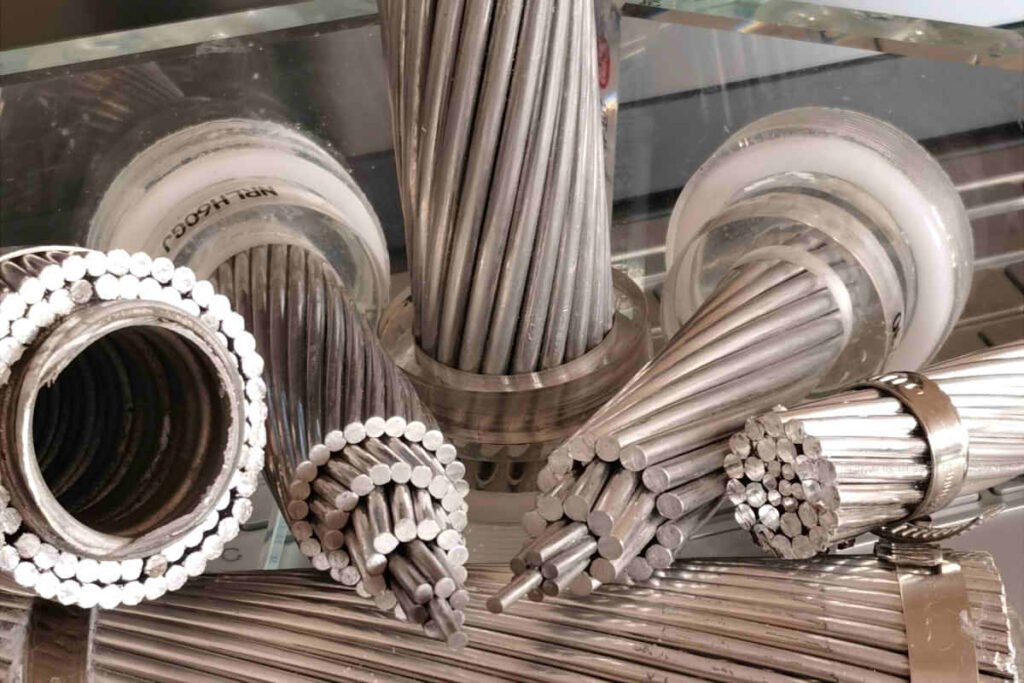
Толығырақ біліңіз Күн жүйесіне арналған үстеме кабель
Байланыс кабельдері күн электр қуатын өндіру жүйесінің дұрыстығына әсер етіңіз?
Күн энергиясын өндіру жүйесінде, Байланыс кабельдерінің негізгі рөлі бақылау сигналдары мен бақылау деректерін беру болып табылады, мысалы, электр қуаты, Жүйелік күй, Қате дабылы, және басқа ақпарат. Бұл кабельдер электр энергиясын беруге тікелей қатыспайды. Сондықтан, Байланыс кабельдері өздері күн электр энергиясын өндіру жүйесіндегі санаудың дәлдігіне тікелей әсер етпейді.
Дегенмен, Егер байланыс кабельдері ақаулар болса (мысалы, сигнал беру, кедергі, немесе ажырату), Бұл деректерді дәл алу немесе тарату мүмкін емес бақылау жүйесіне әкелуі мүмкін, осылайша жүйелік бақылаудың дәлдігі мен уақтылығына әсер етеді. Мысалы, Деректерді беру Кешіктірулер немесе қателіктер техникалық қызмет көрсету қызметкерлерінің электр энергиясын өндіру жүйесінің нақты жұмыс жағдайын жедел түсінуіне немесе дәл емес деректерді жазудан бас тартуға кедергі келтіруі мүмкін, Сонымен, электр қуатын өндіруге және талдауға әсер ету.
Сондықтан, байланыс кабельдері электр энергиясының нақты өндірісіне әсер етпейді, Олар жүйені тиімді басқару және техникалық қызмет көрсету үшін өте маңызды. Бұл жанама түрде күн электр қуатын өндіру жүйесін тиімділік пен тиімділіктің тиімділігін оңтайландыруға қатысты. Байланыс кабельдерінің сапасы мен тиісті техникалық қызмет көрсетуді қамтамасыз ету Күн энергиясын өндіру жүйесінің сенімді мониторингі мен тиімді жұмыс істеуі үшін қажет.
Толығырақ біліңіз PV жүйесіне арналған байланыс және басқару кабелі
Күн жобаларында кабельдік бағыттауға арналған құқықтық және реттеуші талаптар
Нормативтік сәйкестікті түсіну
Күн жобасын жоспарлау және орындау кезінде, Қауіпсіздікті қамтамасыз ету үшін әртүрлі құқықтық және реттеуші талаптарды сақтау қажет, тиімділігі, және жергілікті сәйкестік, ұлттық, және халықаралық стандарттар. Реттеуші органдар мен саясат Күн энергетикалық жүйелерін орнату және пайдалануды басқарады, Соның ішінде кабельдерді бағыттау және таңдау. Бұл талаптарды түсіну сіздің күн жобасын сәтті аяқтау үшін өте маңызды.
Негізгі басқару органдары және стандарттары
Ұлттық электр кодексі (Басқа топ)
Америка Құрама Штаттарында, Ұлттық электр кодексі (Басқа топ) Электр сымдары мен жабдықтарын қауіпсіз орнату үшін стандартты орнатады. Мақала 690 NEC-тің Solar Photovoltaic мекен-жайы бойынша (Пв) жүйелер, Сымдық әдістер сияқты жабдықтар, жерге қосу, және шамадан тыс қорғаныс. NEC нұсқауларын ұстану кабельдің бағытталуы қауіпсіздік пен өнімділік стандарттарына сәйкес келетіндігін қамтамасыз етеді.
Халықаралық электротехникалық комиссия (IEC)
Халықаралық электротехникалық комиссия (IEC) барлық электрлік стандарттарды әзірлейді, электронды, және соған қатысты технологиялар. IEC 62548:2016 Solar PV массивтерін жобалау және орнату бойынша нұсқаулық береді, кабельді басқару және бағыттауды қоса. Халықаралық жобалар үшін IEC стандарттарына сәйкестігі жиі қажет.
Жергілікті құрылыс кодтары
Жергілікті құрылыс кодтары күн қондырғыларына қосымша талаптар қоюы мүмкін, соның ішінде кабельдік маршрут. Бұл кодтар айтарлықтай өзгеруі мүмкін, Сондықтан жергілікті билік органдарымен кеңесу және барлық тиісті ережелердің сақталуын қамтамасыз ету қажет.
Кабельдік маршруттаудың ең жақсы тәжірибелері
Дұрыс таңбалау және құжаттама
Барлық кабельдердің дұрыс белгіленгеніне және бұл жан-жақты құжаттама жүргізілгеніне көз жеткізіңіз. Бұған кабельдік бағыттаудың диаграммалары кіреді, Пайдаланылған кабельдердің техникалық сипаттамалары, және тексерулер мен мақұлдау туралы жазбалар. Тиісті құжаттама нормативтік сәйкестікті және болашақтағы техникалық қызмет көрсетуді жеңілдетеді.
Қорғаныс пен науаларды қолдану
Қорғады және кабель науаларын бағыттау үшін пайдалану үшін кабельдерді физикалық зақымданудан қорғайды, Электрлік ақаулардың қаупін азайтыңыз, Орнатудың жалпы қауіпсіздігін арттыру. Қорғаныс пен науалардың тиісті стандарттарға сәйкестігін және тиісті түрде орнатылғанына көз жеткізіңіз.
Жерге қосу және байланыстыру
Тиісті жерге қосу және байланыстыру күн электр жүйелерінің қауіпсіздігі мен орындалуы үшін өте маңызды. Жерге қосу әдістеріне топтастырылғанына көз жеткізіңіз, IEC, және жергілікті стандарттар. Бұған тиісті жерге тұйықталушыларды қолдану кіреді, қосқыштар, және шыбықтар, және барлық металл компоненттердің тиісті түрде байланыстырылғанын қамтамасыз ету.
Тұрақты тексерулер және техникалық қызмет көрсету
Кәдімгі тексерулер және техникалық қызмет көрсету кабельдің бағытталуы реттеудің талаптарына сәйкес келетіндігін және қауіпсіз және тиімді жұмыс істеуді жалғастыру үшін қажет. Кез-келген мәселелерді анықтау және шешу үшін мерзімді тексерулер кестесі, мысалы, физикалық зақым, кию, немесе коррозия.
Кабельдерді сатып алу үшін маңызды кеңес

Жүйелік талаптарыңызды түсіну
Кабельдерді сатып алмас бұрын, Күн жүйесінің талаптарын нақты түсіну өте маңызды. Жүйенің мөлшерін қарастырыңыз, Пайдаланылған компоненттердің түрлері, және экологиялық жағдай. Сіз таңдаған кабельдердің күтілетін электр жүктемесін шеше алатындығымен және орнату орнының нақты шарттарына сәйкес келетініне көз жеткізіңіз.
Сапа мен сертификаттауды басымдық беру
TÜV сияқты беделді стандарттармен сертификатталған жоғары сапалы кабельдерді таңдаңыз, Уль, немесе IEC. Сертификатталған кабельдер беріктікке тексеріледі, қауіпсіздік, және өнімділік, Олар салалық стандарттарға сәйкес келетіндігін қамтамасыз ету. Сертификатталған кабельдерді пайдалану қуат жоғалту сияқты ықтимал мәселелердің алдын алуға көмектеседі, қыздырғыш, немесе өрт қаупі.
Дұрыс кабель түрлерін таңдаңыз
Күн қосымшаларына арналған кабельдерді таңдаңыз. DC қосымшалары үшін, H1Z2Z2-K және Pv1-F PV кабельдері ультракүлгін сәулелерге төзімділігіне байланысты, Температураның өзгеруі, және механикалық кернеу. Айнымалы қосымшалар үшін, Төмен және орташа кернеудің кабельдерін қолданғаныңызға көз жеткізіңіз.
Экологиялық факторларды қарастырыңыз
Орнату орнындағы экологиялық жағдайларды ескеріңіз. Кабельдер қатал ауа-райы, Ультра күлгін сәуле, немесе мұндай жағдайларды осы жағдайларға икемделеу үшін таңдау керек. Дұрыс оқшаулау және қорғаныс шаралары кабельдердің қызмет ету мерзімін ұзартады және жүйенің тиімділігін қолдауға мүмкіндік береді.
Тиісті орнатуды және техникалық қызмет көрсетуді қамтамасыз етіңіз
Дұрыс орнату дұрыс кабельдерді таңдау сияқты өте маңызды. Кабельдік маршруттаудың озық тәжірибелерін қадағалаңыз, жерге қосу, және электрлік ақаулардың алдын алу үшін қорғаныс. Күнделікті техникалық қызмет көрсету және тексерулер сіздің күн электр жүйеңіздің қауіпсіздігі мен жұмысын қамтамасыз ету үшін қажет.
Нормативтік сәйкестік жоспары
Жергілікті хабардар болыңыз, ұлттық, және сіздің күн жобаңызға қолданылатын халықаралық ережелер. Сіздің кабельді таңдауыңыз бен қондырғыңыз сіздің жүйеңіздің қауіпсіздігі мен сенімділігін қамтамасыз ету үшін осы стандарттарға сәйкес келетініне көз жеткізіңіз.
Соңғы ойлар
Күнделікті желінің дұрыс кабельдерін таңдауға уақыт пен ресурстар инвестициялау ұзақ мерзімді жерде. Сапалы кабельдер қуатты үнемдеуді қамтамасыз етеді, Техникалық қызмет көрсету шығындарын азайту, жүйенің жалпы қауіпсіздігі мен сенімділігін арттыру. Осы нұсқаулықта көрсетілген нұсқаулар мен озық тәжірибелерді орындау арқылы, Сіз күн қондырғысының жетістіктеріне өз үлестерін қосатын шешімдер жасай аласыз.
Есте сақтау, Жақсы жасалған күн электр жүйесі тек панельдер мен инверторлар туралы ғана емес; Бұл компоненттерді қосатын кабельдер бірдей маңызды. Сапа басымдыққа көз жеткізіңіз, көнгіштік, және күн энергиясының толық әлеуетіне дейін дұрыс орнату.

